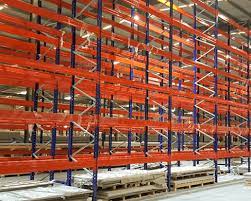Having a well-designed warehouse shelving system can make a significant impact on your business. It can not only improve your warehouse’s productivity but also increase your storage capacity and make it easier for workers to access and move products. However, with so many options available, selecting the right type of warehouse shelving can be overwhelming. This blog post will guide you through the different types and benefits of warehouse shelving systems, helping you make the right choice for your business.
Pallet Racking: This is one of the most common and flexible types of warehouse shelving systems. Pallets are stored on horizontal beams that can be adjusted based on the size of the pallets. Pallet racking is not only great at maximizing storage space, but also makes it easier for workers to access and move products with forklifts. There are multiple types of pallet racking systems, like selective racking, drive-in racking, and push-back racking, each with their own benefits and limitations.
Longspan Shelving: This type of shelving is designed for storing smaller products like boxes, bins, and cartons. It offers greater flexibility than pallet racking, creating shelves that can be adjusted vertically and horizontally. Longspan shelving is great at providing easy access to goods and giving workers better visibility of the products stored. These shelves come in a variety of materials, from steel to wire mesh, to fit the exact needs of the space.
Mobile Shelving: Mobile shelving is used to increase storage space by compacting rows of shelving together. The shelving moves on tracks, allowing workers to access the aisle required to reach the item. It’s perfect for areas where space is limited, as it can increase storage capacity by up to 80%. Mobile shelving also helps organizations comply with safety regulations as product handling occurs within a more confined area.
Mezzanine Floors: Mezzanine floors are built-in over existing floors in a warehouse, creating extra storage space. A mezzanine floor can double the space in a warehouse by utilizing vertical space and creating another floor. The setup and layout of mezzanine floors allow businesses to customize the environment to fit their specific needs. They are also a great solution for when it’s not feasible to expand a warehouse building or if you’re facing leasing restrictions.
Cantilever Racking: Cantilever racking is designed for the storage of large or unusual items, like pipes, tubing, and wood. They are built with long arms that protrude from the frame, which can be adjusted to hold products of different sizes and shapes. Cantilever racking reduces the risk of damage to your products by eliminating some of the pressure created by contact with other products. It’s also ideal for when you need greater flexibility for the positioning of products.
In summary, choosing a warehouse shelving system is key to optimizing your space and providing greater flexibility for your business. The most popular types of warehouse shelving systems, like pallet racking, longspan shelving, mobile shelving, mezzanine floors, and cantilever racking, each offer key benefits based on factors like the size of the products, storage capacity, and accessibility for staffers. Understanding the benefits of each of these systems will help you make the right choice for the specific needs of your business. So, go ahead and optimize your warehouse space by selecting the right shelving system today!

